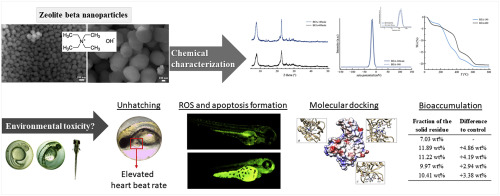Microporous and Mesoporous Materials ( IF 5.2 ) Pub Date : 2020-02-19 , DOI: 10.1016/j.micromeso.2020.110103 Ana Palčić , Sanja Babić , Aleksandra Maršavelski , Maja Galić , Natalija Topić Popović , Ivančica Strunjak Perović , Rozelindra Čož-Rakovac , Josip Bronić , Valentin Valtchev

|
Zeolites are materials widely used in many fields of human activities. Furthermore, new potential applications constantly emerge, so understanding their possible impact on the environment is necessary. Within this study, the potential toxicity of nanosized particles (140 and 600 nm) of a widely used zeolite beta was evaluated using zebrafish Danio rerio embryos. Embryotoxicity test, with an emphasis on sublethal changes, was performed on three concentrations of each nanosized zeolite sample (calcined and non-calcined). Toxicity of tetraethylammonium species (TEA) present in non-calcined zeolite samples was also investigated using experimental and computational approaches. The data suggest that non-calcined zeolites and tetraethylammonium hydroxide (TEAOH) itself caused hatching failure, but also initiated oxidative stress and apoptosis. Such observation confirmed certain TEA leaching from the zeolite framework, thus impacting embryonic development. Since molecular docking and molecular dynamics simulations did not show TEA inhibition of the hatching enzyme ZHE1 and the ROS formation was detected using fluorescence microscopy, it was concluded that oxidative stress is the major mechanism underlying the toxicity of non-calcined samples and TEAOH. Contrary to that, calcined zeolite nanoparticles, although having a strong interaction with the chorion and subsequently with the embryos, did not show a negative impact on zebrafish survival/development. Such a comprehensive study pinpointed zeolite nanoparticles as safe materials and opened the door for their application.
中文翻译:

纳米沸石β-确定斑马鱼Danio rerio胚胎使用的安全性
沸石是在人类活动的许多领域中广泛使用的材料。此外,新的潜在应用不断涌现,因此有必要了解它们可能对环境的影响。在这项研究中,使用斑马鱼Danio rerio评估了广泛使用的β沸石的纳米粒子(140和600 nm)的潜在毒性。胚胎。对每种纳米尺寸的沸石样品(煅烧和未煅烧)的三个浓度进行了胚毒性测试,重点是亚致死性变化。还使用实验和计算方法研究了非煅烧沸石样品中存在的四乙铵物种(TEA)的毒性。数据表明未煅烧的沸石和氢氧化四乙铵(TEAOH)本身会导致孵化失败,但也会引发氧化应激和细胞凋亡。这种观察证实了某些TEA从沸石骨架中浸出,从而影响了胚胎发育。由于分子对接和分子动力学模拟未显示TEA对孵化酶ZHE1有抑制作用,并且使用荧光显微镜检测到了ROS的形成,结论是氧化应激是未煅烧样品和TEAOH毒性的主要机理。与此相反,煅烧的沸石纳米颗粒尽管与绒毛膜和随后与胚胎有很强的相互作用,但对斑马鱼的存活/发育没有负面影响。这项全面的研究确定了沸石纳米颗粒为安全材料,并为其应用打开了大门。


























 京公网安备 11010802027423号
京公网安备 11010802027423号